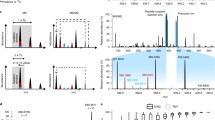Abstract
Besides protein identification via mass spectrometric methods, protein and peptide quantification has become more and more important in order to tackle biological questions. Methods like differential gel electrophoresis or enzyme-linked immunosorbent assays have been used to assess protein concentrations, while stable isotope labeling methods are also well established in quantitative proteomics. Recently, we developed metal-coded affinity tagging (MeCAT) as an alternative for accurate and sensitive quantification of peptides and proteins. In addition to absolute quantification via inductively coupled plasma mass spectrometry, MeCAT also enables sequence analysis via electrospray ionization tandem mass spectrometry. In the current study, we developed a new labeling approach utilizing an iodoacetamide MeCAT reagent (MeCAT-IA). The MeCAT-IA approach shows distinct advantages over the previously used MeCAT with maleinimide reactivity such as higher labeling efficiency and the lack of diastereomer formation during labeling. Here, we present a careful characterization of this new method focusing on the labeling process, which yields complete tagging with an excess of reagent of 1.6 to 1, less complex chromatographic behavior, and fragmentation characteristics of the tagged peptides using the iodoacetamide MeCAT reagent.





Similar content being viewed by others
References
Linscheid MW (2005) Quantitative proteomics. Anal Bioanal Chem 381(1):64–66. doi:10.1007/s00216-004-2921-6
Gerber SA, Rush J, Stemman O, Kirschner MW, Gygi SP (2003) Absolute quantification of proteins and phosphoproteins from cell lysates by tandem MS. P Natl Acad Sci USA 100(12):6940–6945. doi:10.1073/pnas.0832254100
Gygi SP, Rist B, Gerber SA, Turecek F, Gelb MH, Aebersold R (1999) Quantitative analysis of complex protein mixtures using isotope-coded affinity tags. Nat Biotechnol 17(10):994–999
Ong SE, Blagoev B, Kratchmarova I, Kristensen DB, Steen H, Pandey A, Mann M (2002) Stable isotope labeling by amino acids in cell culture, SILAC, as a simple and accurate approach to expression proteomics. Mol Cell Proteomics 1(5):376–386. doi:10.1074/mcp.M200025-MCP200
Ross PL, Huang YLN, Marchese JN, Williamson B, Parker K, Hattan S, Khainovski N, Pillai S, Dey S, Daniels S, Purkayastha S, Juhasz P, Martin S, Bartlet-Jones M, He F, Jacobson A, Pappin DJ (2004) Multiplexed protein quantitation in Saccharomyces cerevisiae using amine-reactive isobaric tagging reagents. Mol Cell Proteomics 3(12):1154–1169. doi:10.1074/mcp.M400129-MCP200
Tholey A, Schaumlöffel D (2010) Metal labeling for quantitative protein and proteome analysis using inductively-coupled plasma mass spectrometry. Trends Anal Chem 29(5):399–408
Bomke S, Sperling M, Karst U (2010) Organometallic derivatizing agents in bioanalysis. Anal Bioanal Chem 397(8):3483–3494
Zinn N, Hahn B, Pipkorn R, Schwarzer D, Lehmann WD (2009) Phosporus-based absolutely quantified standard peptides for quantitative proteomics. J Proteome Res 8(10):4870–4875
Brun V, Dupuis A, Adrait A, Marcellin M, Thomas D, Court M, Vandenesch F, Garin J (2007) Isotope-labeled protein standards. Mol Cell Proteomics 6(12):2139–2149
Ahrends R, Pieper S, Kuhn A, Weisshoff H, Hamester M, Lindemann T, Scheler C, Lehmann K, Taubner K, Linscheid MW (2007) A metal-coded affinity tag approach to quantitative proteomics. Mol Cell Proteomics 6(11):1907–1916. doi:10.1074/mcp.M700152-MCP200
Ahrends R, Pieper S, Neumann B, Scheler C, Linscheid MW (2009) Metal-coded affinity tag labeling: a demonstration of analytical robustness and suitability for biological applications. Anal Chem 81(6):2176–2184. doi:10.1021/Ac802310c
Krause M, Scheler C, Boettger U, Weisshoff H, Linscheid M (2002) Method and reagent for quantifying one or more proteins in a sample. Germany Patent
Pieper S, Beck S, Ahrends R, Scheler C, Linscheid MW (2009) Fragmentation behavior of metal-coded affinity tag (MeCAT)-labeled peptides. Rapid Commun Mass Sp 23(13):2045–2052. doi:10.1002/Rcm.4118
Jakubowski N, Waentig L, Hayen H, Venkatachalam A, von Bohlen A, Roos PH, Manz A (2008) Labelling of proteins with 2-(4-isothiocyanatobenzyl)-1,4,7,10-tetraazacyclododecane-1,4,7,10-tetraacetic acid and lanthanides and detection by ICP-MS. J Anal Atom Spectrom 23(11):1497–1507. doi:10.1039/B800346g
Rappel C, Schaumloffel D (2009) Absolute peptide quantification by lutetium labeling and nanoHPLC-ICPMS with isotope dilution analysis. Anal Chem 81(1):385–393. doi:10.1021/Ac801814a
Wang M, Feng WY, Zhao YL, Chai ZF (2010) ICP-MS-based strategies for protein quantification. Mass Spectrom Rev 29(2):326–348. doi:10.1002/Mas.20241
Yan XW, Xu M, Yang LM, Wang QQ (2010) Absolute quantification of intact proteins via 1,4,7,10-tetraazacyclododecane-1,4,7-trisacetic acid-10-maleimidoethylacetamide-europium labeling and HPLC coupled with species-unspecific isotope dilution ICPMS. Anal Chem 82(4):1261–1269. doi:10.1021/Ac902163x
Byegard J, Skarnemark G, Skalberg M (1999) The stability of some metal EDTA, DTPA and DOTA complexes: application as tracers in groundwater studies. J Radioanal Nucl Ch 241(2):281–290
Whetstone PA, Butlin NG, Corneillie TM, Meares CF (2004) Element-coded affinity tags for peptides and proteins. Bioconjug Chem 15(1):3–6
Acknowledgments
We are very grateful to Proteome Factory AG and Thermo Fisher Scientific, especially Torsten Lindemann and Meike Hamester, for the technical support.
Author information
Authors and Affiliations
Corresponding author
Electronic supplementary material
Below is the link to the electronic supplementary material.
ESM 1
(PDF 132 kb)
Rights and permissions
About this article
Cite this article
Schwarz, G., Beck, S., Weller, M.G. et al. MeCAT—new iodoacetamide reagents for metal labeling of proteins and peptides. Anal Bioanal Chem 401, 1203–1209 (2011). https://doi.org/10.1007/s00216-011-5189-7
Received:
Revised:
Accepted:
Published:
Issue Date:
DOI: https://doi.org/10.1007/s00216-011-5189-7




